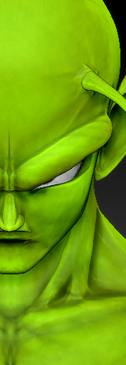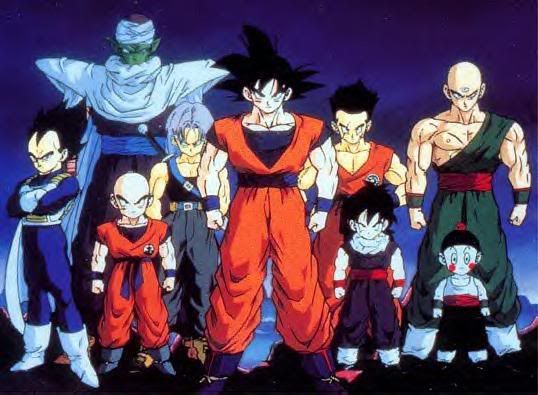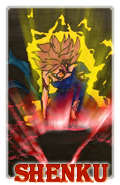| Author |
Message |
Denz
 Exploitative / Efficient
Exploitative / Efficient


|
 Monday, August 22, 2011 Monday, August 22, 2011
Yes, that's the ref I was talking about, nice find Rogan.

Actually TRL, all Dragon Ball Z characters have extremely wide shoulders and small waistline (especially in that shot), that's an easy fix, but more importantly, overall Davidskiwan's reference is on point and has no flaws for a human characters.
If I were to model Tenshinhan I would follow it 95%.
|
Zeth
 The Admin
The Admin


|
 Monday, August 22, 2011 Monday, August 22, 2011
I disagree.
If it didn't come from the series in entirety based on a comprehensive composition of multiple shot components from various angles while accounting for saga changes, distance detailing, camera skews, and lighting deformations, then you aren't going to get anything accurate of out of your result beyond that of a basis of recognition.
You may think it little, but there's a big difference between something 80% accurate and 100%. I've spent more than 2 weeks studying and having an artist replicate Dragon Ball Z armor shoulder pads alone by this process thus I can easily say it's more than a factor of two by comparison due to exponential familiarity in result on the high end.
Although it's not as naturally occurring in things of a stylistic nature, it is similar a phenomena to the issue with the uncanny valley being overcome in realism. I'd like to think of this as attaining proper "cannon valley" -- if you'll allow the crude pun.
|
Denz
 Exploitative / Efficient
Exploitative / Efficient


|
 Tuesday, August 23, 2011 Tuesday, August 23, 2011
I knew you would disagree Zeth, you just didn't state what on.
As I said, I would follow David's reference for overall proportion of the character, with it, I could achieve 95% accuracy, not to mention recognition, which can be done by using even 50 polygons, imagine it like Cubism if you will.
By finishing with David's ref and with 95% accuracy, I could then reference other perspective views and angles from anime and manga, so that I follow its anatomy, stylization, making the silhouette as perfect and achieving that perfection only with my pure mesh without any colors.
I don't see what realism has to do with anime but as you can see with only few adjustments after David's reference, thumbs up from rookie and pro spectators, I could even pull out uncanny valley effect from them.
Also, 99% Budokai resemblance is the way to go with it to please you, I guess. Then I strongly suggest that.
|
Zeth
 The Admin
The Admin


|
 Tuesday, August 23, 2011 Tuesday, August 23, 2011
None of the commercial games have even came close to Dragon Ball Z accuracy. Why would I be supportive of a Budokai concept? ZEQ2-lite styling never had an abasement in ANY commercial game (ask anyone who has ever worked with me). Perhaps you are thinking Earth Special Forces's map styles?
Skiwans reference gives you a rough 60-70% accuracy tops, while the commercial games might dip into 80% (barely and only on some games). Dragon Ball Z mesh accuracy replication is all about the face & head. If you lack that, you have nothing. Aside from that, there are things that come into play like silhouette and crease inking density, shade wrapping, distance falloffs, and things like dynamic/screen-space (or particle-based) inking for last mile touches like full-front nose outlines, vein formations, wrinkles, etc. -- of which no "commercial" game has even vaguely attempted.
It's quite clear you are intentionally trying to rile me up here, but I will still respond to indicate my positioning on the matter. If you sincerely DO idolize and respect the commercial games as being truly accurate in a visual (or dare I say mechanical) sense, then I suggest you widen your perception on the matter.
10-15 year old non-photo-realistic rendering techniques just don't cut it. There's a reason a whole area of computer science exists just for that category, you know.
I don't see what realism has to do with anime but as you can see with only few adjustments after David's reference, thumbs up from rookie and pro spectators, I could even pull out uncanny valley effect from them.
I was using the opposite spectrum of accuracy as a basis of comparison (as I had stated prior). While it's a different process entirely when dealing with that which is more abstract, my research would indicate there exists a threshold to cross in which distinction becomes indistinguishable between that of a hand-drawn 2D cel/animation and it's 3D counterpart -- a barrier/valley which is still quite strong even today.
There's a world of difference between recognition and replication. What I'm discussing is an industry-changing ideal that's the equivalency of introducing the automobile to a horse-drawn-carriage culture. It is the culmination of decades of research and development by myself and many other individuals (many outside the scope of the ZEQ2 project).
|
Denz
 Exploitative / Efficient
Exploitative / Efficient


|
 Tuesday, August 23, 2011 Tuesday, August 23, 2011
Sorry for my temperament post, had some other issues in mind at that moment and I transferred bad energy on to you. I always enjoy reading your thoughts and ideas and fully support them 95%.
About Budokai comparison and ZEQ2-lite vs Earth Special Forces, we will keep it at closed subject, will only lead in wasted time.
cheers
Postscript. I suggest you delete last few posts to keep this thread clean.
|
Zeth
 The Admin
The Admin


|
 Tuesday, August 23, 2011 Tuesday, August 23, 2011
I consider this a gentlemen's debate (an informative one at that) and thus could easily be a thread on it's own. Split.
|
TRL



|
 Wednesday, August 24, 2011 Wednesday, August 24, 2011
Denz wrote : I always enjoy reading your thoughts and ideas and fully support them 95%.
Haha good line!
The problem with turning 3D into 2D animation lies in the inherent inaccuracies of 2D animation. When you animate a 3D model and move it along the screen, the perspectives and proportions are always going to be 100% realistic and accurate in each frame of the animation. That's something that's never been achieved in 2D animation, easily explained because it comes from the human hand.
So because of the smoothness in movement and accuracy in changing perspectives, I think you will always be able to tell you're looking at 3D.
|
Zeth
 The Admin
The Admin


|
 Wednesday, August 24, 2011 Wednesday, August 24, 2011
If it can explained and performed by a human as a process, then it can be replicated codewise. Simple as that.
You must have not have looked far into the science of NPR if you truly believe that mesh deformation or per-frame animation inking perturbations aren't replicate-able.
Altering a mesh, it's inking (outlines) density/strokes, shading, and it's transitions on any changed frame based on distance, rotation, or spatial comparisons to replicate that of drawing the frame by hand can be completely reproduced in an accurate and indistinguishable manner.
The problem is that you are looking to the wrong places for this. Games/movies/media are incredibly atrocious examples being that they are roughly about a decade behind that of active research concerning implementation approaches.
Just because the mediums you are readily familiar with rarely step into new realms of exploration (primarily due to risky deployment) hardly means that methods for creating such steps simply do not exist.
Look. If you aren't going to do your homework on the matter or at LEAST think out of the box and try to theorize practical concepts within the scope of your understanding, then don't bother engaging in a debate from which you have little basis in knowledge of facts.
I am by no means intending to be rude or pompous, but my point stands that you would not see me approaching a particle physicist with argumentative ideas combating quantum mechanics just because I have a loose understanding of string theory -- whereas likewise your level of comprehension falls rather incomplete in terms of the debate you are engaging.
----
My point is this. You should look into the subject matters at hand before you callously declare them impossible.
|
TRL



|
 Wednesday, August 24, 2011 Wednesday, August 24, 2011
Yo Brad I'm not going to go read your research papers just to be part of this conversation.
I am full aware that it could be technically done. Like you said changing the mesh each frame is perfectly doable.
Still my statement stands, because why would you do that? Screw up proportions deliberately and introduce human errors just for likeness?
Sounds like extra work for, less "quality".
The human hybris is way too big for that, just as yours is in saying that everything is replicable.
Of course if you were doing this exact replication just to prove a point, fine.
But in commercial or any kind of logical work flow setting, you would not do this one step forward, two steps back approach.
The commercial world has come to accept that 3D and it's perfect and smooth animation and perspectives is the future.
So "my" point is your point is invalid. :p
|
Zeth
 The Admin
The Admin


|
 Wednesday, August 24, 2011 Wednesday, August 24, 2011
Your argument is that the tens of thousands of researchers out there working in this field of science are doing frivolous and pointless work despite the active industry adapting it's developments readily (albeit slowly). Do you seriously not grasp that imperfection is the way paved to perfection? Even advocates simulating realistic textures and facial expressions have come to realize this.
NOBODY wants perfectly smooth/clean and surgically precise results in 3D. Sure, that may have been a goal in 1999, but games and movies in recent times have been striving FAR away from perfectly clean 3D results. Things like asymmetrical composites, noise details, particle embeds, procedural animations, and random perturbations in many schemes have been prevalent for QUITE a while now in both realistic and stylistic art forms.
Your ignorance is deafening.
Stop wasting everyone's time, TRL.
|
TRL



|
 Thursday, August 25, 2011 Thursday, August 25, 2011
O-Kay!
Though none of those terms you just threw out there had anything to do with what I was saying. Maybe procedural animation a little, but not quite. You just think I'm against the notion that it's possible. Which is not the case.
|
Shenku
 RiO Incarnate
RiO Incarnate


|
 Friday, August 26, 2011 Friday, August 26, 2011
Brad's right though. Nobody's perfect, and nobody's movements are perfectly smooth, so why should 3D Models be made "perfectly"?
There is no such thing as a "perfect" anything, as there are always flaws in some form, no matter what the case may be.
That said though, if you were a developer in a commercial studio with development leaders breathing down your neck to work faster, which method would you go with. Models that look 98% accurate compared to the source, or the 65% accurate models that take a quarter the time? That's a commercial environment though, and that's also assuming they're developing with quantity in mind, rather than quality.
A great quality game sells well, and lots of money can be made if it's good enough, but the problem is the time investment in such an endeavor. Most studios however, seem to go the route of quantity instead, and just release bad game after worse game hoping that the larger number of games released works out to return more money faster.
Not an accurate example in terms of numbers, but the point is still the same.
1 Great game = 2+ year development = $20 million worth sold.
5 Semi-Okay games = 6 month development each = $5-10 million worth sold each.
While the numbers are lower individually for the faster made games, combined they easily generate more money overall.
I think Square Enix is a good example of a development house that makes games for both quality and quantity. Their main Final Fantasy franchise is always focused on quality, but almost every other game they make and sell is predominately much lower in standards, and really only seems intended to make enough money for them to make the next Final Fantasy in the series, since each one costs them so much to produce.
Granted, the last few Final Fantasy games missed the mark completely... Personally, I think that everything from 11 onwards felt stale and generic, and 10 lost a lot of brownie points with the addition of 10-2, which completely destroyed the feel of the world and it felt so much like a bad parody of Charlies Angels that I couldn't play it for more than an hour...(The first game's story starts out with Yuna as the conservative and meek non-combatant who feels that machina is blasphemy, and only a few years later in the second game she's dual wielding guns(which are considered machina in this world...) and fighting like a badass like she's done it her whole life... What the heck? No one can completely change their lifestyle and personality so completely in so short of a time, and changes like that typically need a transitionary period in the game to convey character development from one role to another...)
Well now, it seems I kind of went off on a tangent...
|
